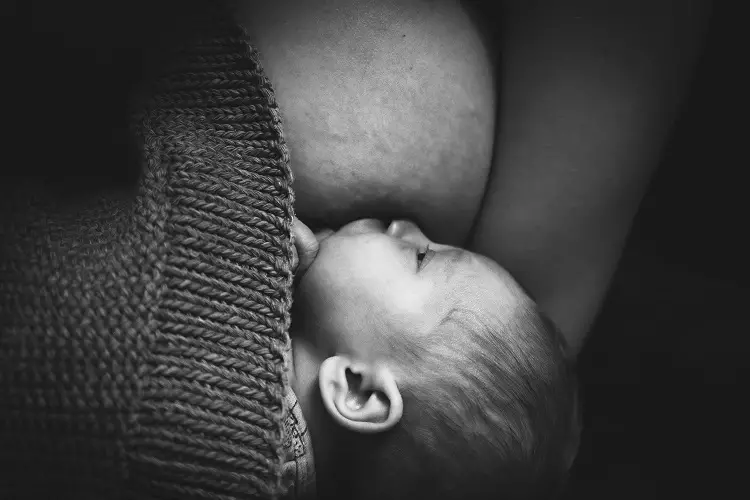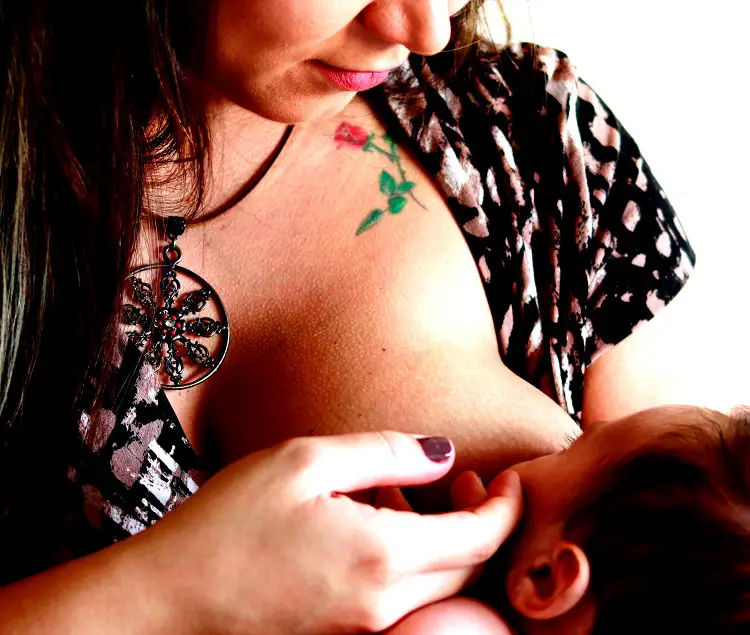Nothing can be more stressful than worrying if you’re producing enough breast milk for your baby during nursing days.
How do I increase milk supply in one breast? How long does it take for breast milk to dry up? What happens when if baby drinks spoiled breast milk are some questions mothers often worry about.
During breastfeeding, babies may prefer one breast over the other, which can lead to an imbalance in breast milk production.
This may be due to some reasons like the comfort of a breastfeeding position or the milk letdown of that breast.
Nevertheless, it’s common for one breast to produce more milk than the other, there are some things you can do to increase the milk supply in the lower producing breast. Keep reading to find out how to increase your milk supply fast.
Is It Ok For One Breast To Produce More Milk?
Breasts produce milk according to the basics of demand-and-supply. So, if you or your baby prefers let’s say, the left breast over the right one, it’s expected that the left breast will produce more milk than the other.
It is normal to say that the other breast will experience low milk production. As a nursing mother, it is normal that when your body senses that there is a greater demand for milk from one side, it produces a larger quantity of breast milk on that side to meet the baby’s demand.
Reasons For Low Milk Supply In The Breast?
There are several factors for the uneven production of breast milk in a nursing mother. Some of these reasons are:
1. The Baby/Mother Has a Breast Preference
If your baby prefers one breast over the other and feeds more on the preferred side, there will be more milk supply in one breast.
Therefore, continuously breastfeeding on one side produces more milk in that breast in nursing mothers. Hence, milk production and let-down reflex are triggered by the baby’s suckling.
2. Surgeries and Injuries
If one of your breasts has been operated on, chances that milk production may reduce in that breast. More so, injuries can also affect breast milk production. So, if you’ve been injured to a particular breast in the past, it may have damaged the milk ducts and reduced milk production.
3. Anatomical Differences
Both the breasts aren’t the same, since one breast can have more milk ducts than the other. The structure of the nipples also varies. Hence, it is easy for your baby to latch on to the nipple of one breast than the other.
Read Also: How To Increase Nipple Size
4. Variations in Let-Down Reflex
The pressure with which milk is released from the breasts also makes a difference. If the let-down reflex in one breast is less forceful than the other, the baby may not like feeding on that breast.
Alternately, if the let-down is too forceful, the baby may have trouble swallowing the breast milk quickly and this can discourage him from sucking from that breast.
3 Indications That Baby Isn’t Getting Enough Breast Milk
Although low milk supply is rare, your baby may still struggle to get enough for other reasons during his first few weeks. He may not be breastfeeding as enough, or long enough, particularly if you’re trying to stick to a breastfeeding routine rather than his feeding demands.
She may not be latching well or might have a condition that makes it difficult for him to take in milk. The following are signs that your baby is not getting enough milk as required:
Poor Weight Gain
Usually, newborns tend to lose 5% to 7% of their birth weight in the first few days some lose up to 10%.
However, after that, your baby should gain at least 20 to 30 g (0.7 to 1 oz) per day and be back to their birth weight by day 10 to 14.5,6,7 if your baby has lost 10% or more of her birth weight, or she hasn’t started gaining weight by days five to six, you should seek medical advice immediately.
Insufficient Wet Or Dirty Nappies
The number of poos and wees your baby has per day is a good indicator if he is getting enough milk. Consult a medical practitioner if you’re worried or if you have noticed her dirty nappies decreasing in wetness and heaviness.
Dehydration
If your baby has dark-colored urine, a dry mouth, or jaundice (yellowing of the skin or eyes), or if she is lethargic and reluctant to feed, she could be dehydrated. Fever, diarrhea, and vomiting, can cause dehydration in babies. If you notice any of these symptoms, consult your doctor quickly.
Read Also: How To Refill Your Breast Milk Faster (10 Helpful Tips)
How Do I Increase Milk Supply In One Breast?

As a nursing mother, there are some things you can do to stimulate your breasts to produce the same quantity of milk. Here they are:
- Firstly, you can start breastfeeding from the breast that produces less milk. When your baby suckles from the breast he fancies less, it will stimulate breast milk production.
- Use a breast pump to pump out the milk from the smaller breast for about 5-10 minutes after a nursing session. This will also help in increasing milk production in the weaker breast. However, you can store this milk and feed it to your baby later or during night time.
- Massage the breast the baby preferred less breast with your hand, and apply a warm compress to it for a few minutes. These techniques will stimulate milk production.
- You can also try out new nursing positions to make it comfortable for your baby to feed on the breast that produces less milk.
- You can also offer the breast that your baby preferred less when your infant is drowsy or tired.
- During each feeding, start with the breast that produces less milk and switch sides at least 2-3 times.
- Breastfeed whenever your baby wants it. Don’t delay or postpone feeding time. Emptying the breast increases milk production. Therefore, it is best advised to breastfeed your baby every 2 hours during the day and every 3 hours during the night.
- Ensure that your baby latches on to the nipple well and feeds properly. If your baby finds it difficult latching, speak to a lactation consultant immediately.
- If your little one is less than 6 months old, you can exclusively breastfeed him for the first 6 months. Formula milk will fill your baby’s belly, making him reduce his intake of breast milk.
- It is best advised to avoid pacifiers, nipple shields, and bottle feeding because these can cause nipple confusion.
- Always drink enough water and sleep well for optimal breast milk production. Should in case you feel that your milk production is low, you can speak to your healthcare provider about using a galactagogue. This is either a prescription medicine or a natural substance that aid in synthesizing breast milk. Examples of some herbal galactagogues that can help you produce more milk include fenugreek leaves and seeds, garlic, fennel, barley, and alfalfa.
- More so, you could also try having more skin-to-skin contact method with your baby before and during feeds to stimulate the oxytocin hormone, which gets your milk flowing.
Read Also: How To Store Formula Milk For Night Feeds
Does An Unequal Breast Milk Production Affect My Baby?

As long as you nurse on demand, your baby will get enough breast milk to fulfill his nutritional needs. Even if one of your breasts produces less milk, the other breast will produce more milk to compensate the other.
Every mother has a different experience when it comes to breastfeeding their babies. As long as you are feeding with the other milk, you do not have to panic when one of your breasts produces less milk.
More so, how you take care of your body plays a vital role in the production of breast milk, so take ample rest, eat nutritious foods, and stay hydrated.
Here are a few ways to do that. Note that it will take some time probably about a week or more to see an increase in milk output on the slacker side because it takes a few days for your body to produce milk supply in response to increased demand.
1. At The End Of Every Pumping Session, Keep Pumping The Slacker Side For A Few More Minutes
To get this done, once you’re done pumping for your normal time, stop the pump and set yourself up to single pump only the slacker side. (Note, most double electric breast pumps allow you to single pump by removing the tubing from your pump parts on one side and covering that side’s tubing port.
Always check your pump’s instruction manual handbook if you’re confused on how about to go about it – most manufacturers have them online.)
Then on your good side, you can either leave your pump parts and bottle in place without the tubing connected or put a breast pad on that side. This is necessary because when your milk lets down, it will let down from both sides. Hence, by doing this you won’t leak milk all over the place.
Then begin pumping in the letdown/massage phase and shift into the expression phase after a few minutes. You can stop either after the next letdown is completed, or after about 10 minutes is up.
2. More Breast Compress Should Be On The Side That Doesn’t Produce As Much Milk
Breast compressions is a great way to get more milk from your breast when you pump. You can focus your efforts on getting more out of the lazy side while you’re already pumping If you don’t want to pump any more than you already do.
To do breast compressions, massage the less preferred side while you pump, moving your hands around and pushing as much milk out of the milk ducts as possible.
Give yourself a break every few minutes to let your hands rest and then start again. Note: With a hands-free bra it is much easier to do this.
3. Add An Extra Pumping Session For Only The Lazy Side Of Your Breast
If adding a few minutes to each session doesn’t work for your schedule, you can try just adding one pumping session for the day that is just for the low-producing side. To achieve this, hook yourself up on just the lazy side, and pump for about 15 minutes.
To prevent leaks, it is best advised you use a milk catcher or breast pad on the other side because as mentioned above, your milk will let down on both sides. At your next pumping session, you should pump as you normally would on both sides.
4. Power Pump The Low-Producing Side.
Power pumping is an aids to simulate cluster feeding. To get this done properly, first pump on and off for about an hour – generally 20 minutes on, 10 minutes off, 10 minutes on, 10 minutes off, and so on, though the exact intervals do not matter much.
Read Also: Indian Foods To Increase Breast Milk (12 Foods To Try)
Some Misconceptions About Low Milk Supply
Usually, babies typically feed very often. Mostly, 10 to 12 times a day, or every two hours and this is not an indication that you don’t have enough milk. Always, remember babies also nurses for comfort, and it’s hard to predict how much milk your baby takes during each feed – amounts can vary.
The following facts are all normal and are no indications of a poor milk supply:
- The baby wants to feed frequently.
- The baby doesn’t want you to put him down.
- Your baby is waking in the night.
- Short feeds.
- Long feeds.
- Your baby takes a bottle after each feeding session.
- Your breasts feel softer than usual.
- Your breasts don’t leak milk, or they used to leak sometimes but have stopped.
- You can’t pump much milk.
- You have small breasts.
Related Posts:
- How To Relieve Sore Nipple While Breastfeeding
- How Long Does It Take For Breast Milk To Dry Up?
- Can I Breastfeed My Husband? Everything You Need To Know
- How Long Did You Breastfeed?
- Foods That Make Breast Milk Taste Good
- Does Kissing Your Baby Change Your Breast Milk
Conclusion
We hope this article has provided you with great ideas on how to increase milk supply in one of the breasts. If you have any other suggestions that have worked for you in the past, we would love to hear it by dropping your comment or suggestion down below.
